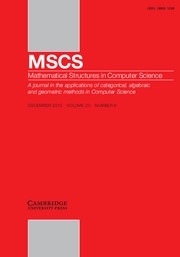No CrossRef data available.
Article contents
Introduction: computability of the physical
Published online by Cambridge University Press: 06 September 2012
Extract
Albert Einstein encapsulated a commonly held view within the scientific community when he wrote in his book Out of My Later Years (Einstein 1950, page 54)
‘When we say that we understand a group of natural phenomena, we mean that we have found a constructive theory which embraces them.’
- Type
- Introduction
- Information
- Mathematical Structures in Computer Science , Volume 22 , Special Issue 5: Computability of the Physical , October 2012 , pp. 723 - 728
- Copyright
- Copyright © Cambridge University Press 2012
References
Axtell, R. and Epstein, J. (1996) Growing Artificial Societies: Social Science from the Bottom Up, The MIT Press.Google Scholar
Bennett, C. H, Gàcs, P., Li, M., Vitányi, M. B. and Zurek, W. H. (1998) Information distance. IEEE Transactions on Information Theory 44 1407–1423.CrossRefGoogle Scholar
Calude, C. S. and Stay, M. A (2008). Most programs stop quickly or never halt. Advances in Applied Mathematics 40 295–308.CrossRefGoogle Scholar
Calude, C. S. and Stay, M. A. (2006) Natural halting probabilities, partial randomness, and zeta functions. Information and Computation 204 1718–1739.CrossRefGoogle Scholar
Calude, C. S., Staiger, L. and Terwijn, S. A. (2006) On partial randomness. Annals of Pure and Applied Logic 138 20–30.CrossRefGoogle Scholar
Chaitin, G. (1975) A theory of program size formally identical to information theory. Journal of the ACM 22, 329–340.CrossRefGoogle Scholar
Dowker, H. F. (2005) Causal sets and the deep structure of space–time. In: Ashtekar, A. (ed.) 100 Years of Relativity – space–time Structure: Einstein and Beyond, World Scientific 445–464.CrossRefGoogle Scholar
Epstein, J. (2007) Generative Social Science: Studies in Agent-based Computational Modeling, Princeton University Press.Google Scholar
Fredkin, E. and Toffoli, T. (1982) Conservative logic. International Journal of Theoretical Physics 21 219–253.CrossRefGoogle Scholar
Gàcs, P., Hoyrup, M. and Rojas, C. (2009) Randomness on computable metric spaces: A dynamical point of view. In: Albers, S. and Marion, J.-Y. (eds.) 26th International Symposium on Theoretical Aspects of Computer Science (STACS) 469–480.Google Scholar
Kittock, J. (1994) Emergent conventions and the structure of multi-agent systems. In: Nadel, L. and Stein, D. (eds.) 1993 Lecture Notes in Complex Systems: Proceedings of the 1993 Complex Systems Summer School, Santa Fe Institute Studies in the Sciences of Complexity VI, Addison Wesley Publishing Co.Google Scholar
Kolmogorov, A. N. (1965) Three approaches to the definition of the quantity of information. Problems of Information Transmission 1 3–11.Google Scholar
Levin, L. A. and Zvonkin, A. K. (1970) The complexity of finite objects and the development of the concepts of information and randomness by means of the theory of algorithms. Russian Mathematics Surveys 256 83–124.Google Scholar
Longo, L. (2012) Interfaces de l'incomplètude, pour ‘Les Mathématiques’, Editions du CNRS. (English version available at http://www.di.ens.fr/users/longo/download.html.)Google Scholar
Manin, Y. (2011) Renormalization and computation I: Motivation and background. In: Loday, J.-L. and Vallette, B. (eds.) OPERADS 2009. Séminaires et Congrès 26, Société Mathématique de France 181–233.Google Scholar
Manin, Y. (2010) A Course in Mathematical Logic (the second, expanded Edition), Springer-Verlag.CrossRefGoogle Scholar
Solomonoff, R. J. (1964) A formal theory of inductive inference, part I. Information and Control 7 1–22.CrossRefGoogle Scholar
Szilard, L. (1929) On the decrease of entropy in a thermodynamic system by the intervention of intelligent beings. Zeitschrift für Physik 53, 840–856. (English translation (2003) In: Leff, H. S. and Rex, A. F. (eds.) Maxwell's Demon 2: Entropy, Information, Computing, Adam Hilger.)CrossRefGoogle Scholar
Tadaki, K. (2002) A generalization of Chaitin's halting probability Ω and halting self-similar sets. Hokkaido Mathematical Journal 31 219–253.CrossRefGoogle Scholar
Tadaki, K. (2008) A statistical mechanical interpretation of algorithmic information theory. In: Local Proceedings of Computability in Europe 2008, University of Athens, Greece 425–434.Google Scholar
Tadaki, K. (2009) Fixed point theorems on partial randomness. In: Proceedings of the Symposium on Logical Foundations of Computer Science 2009. Springer-Verlag Lecture Notes in Computer Science 5407 422–440.CrossRefGoogle Scholar


